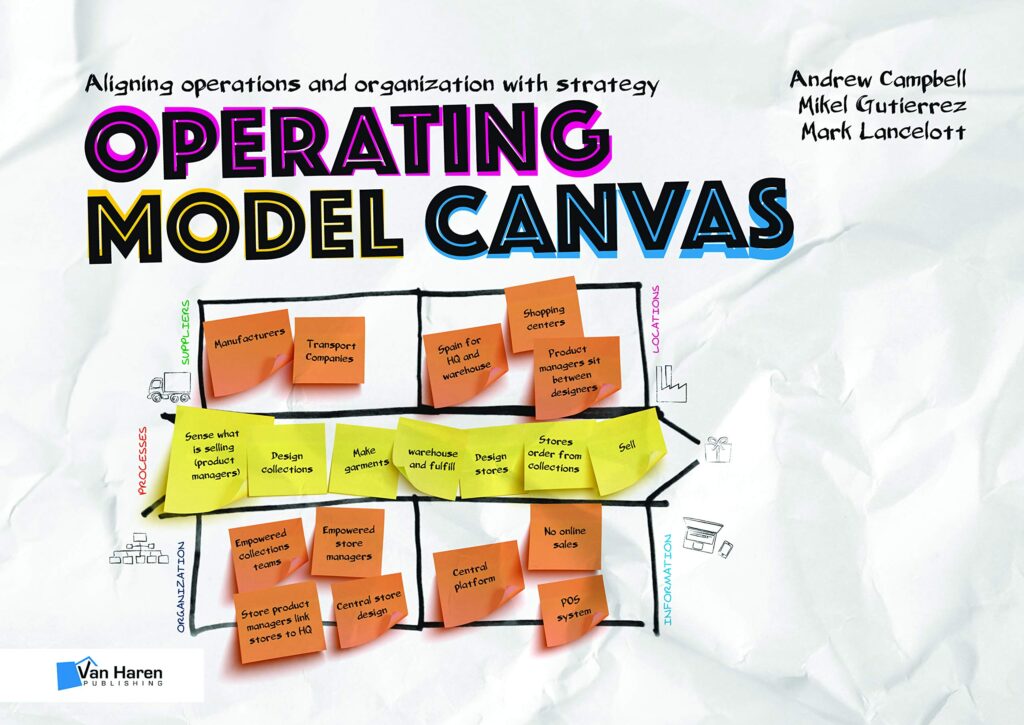Operating Model Canvas
Aligning Operations and Organization with Strategy
By Andrew Campbell, Mikel Gutierrez, and Mark Lancelott
Outside of the many e-books, articles, and white papers published by leading consulting firms, I was surprised at the lack of business literature written on the topic of operating model design. Operating Model Canvas: Aligning Operations and Organization with Strategy is a 2017 book written by Andrew Campbell, Mikel Gutierrez, and Mark Lancelott.
The authors were influenced by Business Model Generation by Alexander Osterwalder and Yves Pigneur and adopted a similar design esthetic for Operating Model Canvas. While the design is undoubtedly attractive, it feels over-stylized, with picture book elements used at the expense of a more substantial narrative to guide the reader through the material. The benefit of the design is it makes the content easy to read and the topics more accessible, especially at a glance. In addition, the book successfully presents information in digestible chunks via glossy two-page spreads.
Campbell, Gutierrez, and Lancelott do an admirable job presenting a comprehensive and workable operating model framework with a robust complement of tools and techniques that readers can use in practice. The Process, Organization, Locations, Information, Suppliers, and Management System framework (POLISM) is more robust than many of the variations of people, processes, and technology I’ve seen and used in practice.
I agree with the authors’ point that mapping the value chain for each customer segment (i.e., the “P” in POLISM) is a foundational first step in the operating model design journey; I appreciated the emphasis placed on its importance throughout the book. I also welcomed the author’s humble positioning of the framework. Operating model design is not a paint-by-numbers exercise, and consequently, some aspects of POLISM may be more or less relevant depending upon the business problem. However, from the perspective of framework design, POLISM is useful and suitable for anyone to start developing an operating model.
With that said, I struggled to grasp the purpose of the POLISM canvas itself. Though the authors included many examples in the book, I found myself wondering about the most impactful way to use the canvas with clients. For example, what exactly should I write on all these sticky notes?
Despite this potential limitation, many of the accompanying tools presented in the operating model toolbox in chapter three align with the approaches we use at Burnie Group when we work with our clients on a target operating model design. These tools include value chain mapping, IT blueprint, decision grid, and organizational models. In addition, the authors effectively organized and aligned the tools to the POLISM framework, making the chapter meaningful for operating model designers of all experience levels. I thought the chapter on the operating model toolbox was the most valuable section of the book. I learned about a handful of tools I didn’t know already that I will incorporate into our work in the future.
For those who may find the tool descriptions included within the book too high-level, Campbell created an accompanying website and blog that contains additional instruction, context, and musings on the content and tools presented in Operating Model Canvas. Fortunately, you do not need to purchase the book to access the site, making it a viable alternative for anyone interested in the subject matter.
Overall, I would recommend Operating Model Canvas as a valuable resource for those wanting to learn more about operating model design. Despite the stylized presentation, this book has more substance than one would assume by only completing a quick flip. From start to finish, it’s easy to read with useful and relevant content that covers many of the important considerations of operating model design.
If you are looking for a dense, authoritative textbook on operating model design, Operating Model Canvas isn’t it. However, if you are interested in a quick reference guide to help you think about and approach the challenge of operating model design, Operating Model Canvas is worth reading.
Learn more about target operating model design.
READ MORE
